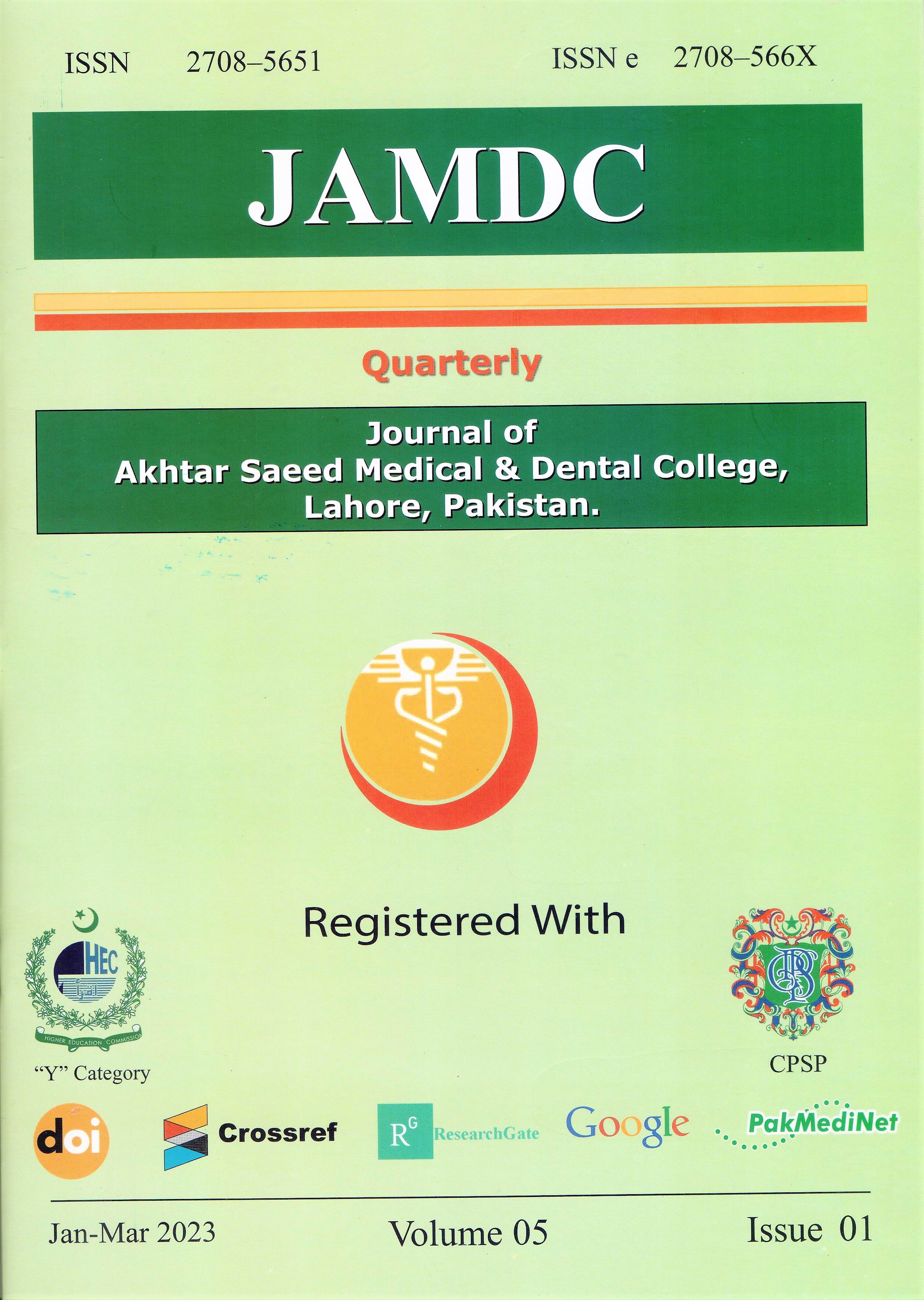Orignal Article To determine the frequency of clostridium difficile infection in antibiotic associated diarrhea.
Keywords:
Clostridium difficleAbstract
Abstract:
Objective: To determine the frequency of clostridium difficile infection in antibiotic associated diarrhea.
Study Design: Cross sectional study, Descriptive
Setting: Department of Gastroenterology, outpatient clinic and ward, AIMC/ Jinnah Hospital, Lahore
Duration of Study: Study was carried out over a period of eighteen months from 23 May 2019 to 23 November 2020.
Material and Methods: 234 patients fulfilling the selection criteria were enrolled in the study from outpatient department and ward of Gastroenterology, Jinnah Hospital Lahore. Informed verbal consent was obtained and patients were subjected to focused history and physical examination as well as their demographic details was recorded. Antibiotic taken by patient were documented. Antibiotic was withdrawn and patient was treated per hospital protocol. Stool culture was sent for all patient to see CDI. Patient was labelled as CDI positive if stool culture is positive. All this information was recorded on predesigned annexure.
Results:Out of 234 cases of antibiotic induced diarrhea; Mean Age was 55 ±13 years years (minimum was 27 and maximum was 66 years) 56% cases were male and 44% cases were female, 28.6% cases had age ˂ 50 years and 71.4% cases had age ≥ 50 year, 54.7% cases used Beta-Lactam antibiotics and 45.3% cases used non- Beta-Lactam antibiotics, 68.4% cases had Bristol grade 6 and 31.6% cases had Bristol grade 7. Out of 234 cases of antibiotic associated diarrhea; 43.6% cases had CD infection and 56.4% cases had No CD infection. Stratification 0f CDI was done with regards to age groups, Gender, type of antibiotic used and Bristol grade; p-value was found to be 0.35, 0.41, 0.4 and 0.03 respectively.
CONCLUSIONS: Majority of patients of antibiotic induced diarrhea were male, had older age, used Beta-lactam antibiotics, had Bristol grade 6 and had non-CD infection. Regarding CD infection; it was more common in older age, female gender and Beta-lactam antibiotic users; but associations were not significant. However CD infection was more common in antibiotic induced diarrhea of Bristol grade 7 and the association was significant.
Keywords: Antibiotic associated diarrhea, Clostridium difficile infection, Bristol grade
References
Hall AJ, Curns AT, McDonald LC, Parashar UD, Lopman BA. The roles of Clostridium difficile and norovirus among gastroenteritis-associated deaths in the United States, 1999–2007. Clin Infect Dis. 2012;55(2):216–223.
Jones AM, Kuijper EJ, Wilcox MH. Clostridium difficile: a European perspective. J Infect. 2013;66(2):115–128.
Karanika S, Paudel S, Zervou FN, Grigoras C, Zacharioudakis IM, Mylonakis E. Prevalence and Clinical Outcomes of Clostridium difficile Infection in the Intensive Care Unit: A Systematic Review and MetaAnalysis. Open Forum Infect Dis. 2016;3:186.
Chen YB, Gu SL, Wei ZQ, Shen P, Kong HS, Yang Q, Li LJ. Molecular epidemiology of Clostridium difficile in a tertiary hospital of China. J Med Microbiol. 2014;63(4):562–569.
Hawkey PM, Marriott C, Liu WE, Jian ZJ, Gao Q, Ling TK, et al. Molecular epidemiology of Clostridium difficile infection in a major Chinese hospital: an underrecognized problem in Asia? J ClinMicrobiol. 2013;51(10):3308–3313. 78
Naqvi SAH, Chaudhry FF. Clostridium difficile postantibioticdiarrhoea diagnosis. J Coll Physicians Surg Pak. 2012;22(10): 640-643
Kyne L, Warny M, Qamar A, Kelly CP. Asymptomatic carriage of Clostridium difficile and serum levels of IgG antibody against toxin A. N Engl J Med. 2000;342:390–7.
Kyne L, Warny M, Qamar A, Kelly CP. Association between antibody response to toxin A and protection against recurrent Clostridium difficile diarrhoea. Lancet. 2001;357:189–193.
Johnson S, Clabots CR, Linn FV, Olson MM, Peterson LR, Gerding DN. Nosocomial Clostridium difficile colonisation and disease. Lancet. 1990;336:97–100.
Simor AE. Diagnosis, management, and prevention of Clostridium difficile infection in long-term care facilities: a review. J Am Geriatr Soc. 2010;58:1556–64.
Kelly CP, LaMont JT. Clostridium difficile: more difficult than ever. N Engl J Med. 2008;359:1932–40. 57. Vedantam G, Clark A, Chu M, McQuade R, Mallozzi M, Viswanathan VK. Clostridium difficile infection: toxins and non-toxin virulence 85 factors, and their contributions to disease establishment and host response. Gut Microbes. 2012;3:121–134.
Pothoulakis C, Lamont JT. Microbes and microbial toxins: paradigms for microbial-mucosal interactions II. The integrated response of the intestine to Clostridium difficile toxins. Am J Physiol Gastrointest Liver Physiol. 2001;280:G178–G183.
Schwan C, Stecher B, Tzivelekidis T, et al. Clostridium difficile toxin CDT induces formation of microtubule-based protrusions and increases adherence of bacteria. PLoS Pathog. 2009;5:e1000626.
Nord CE, Kager L, Heimdahl A. Impact of antimicrobial agents on the gastrointestinal microflora and the risk of infections. Am J Med. 1984;76(5A):99–106.
Chang JY, Antonopoulos DA, Kalra A, et al. Decreased diversity of the fecal microbiome in recurrent Clostridium difficile-associated diarrhea. J Infect Dis. 2008;197:435–8.

